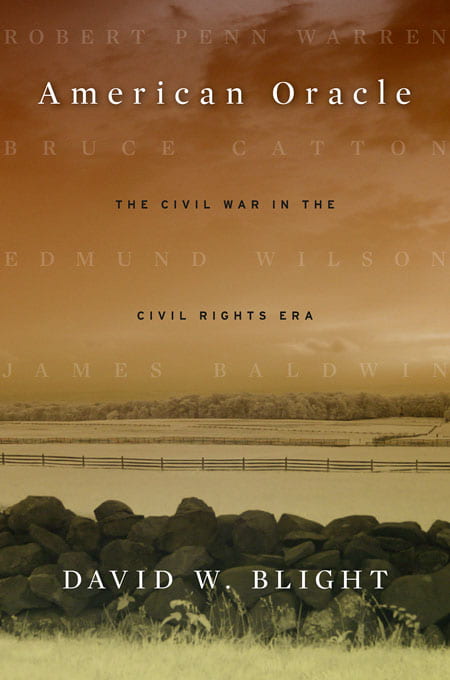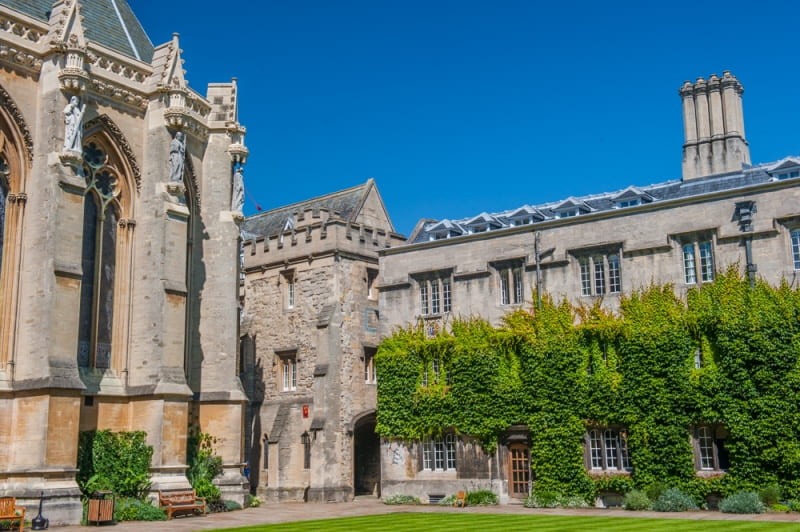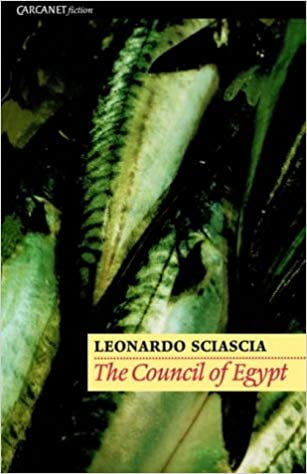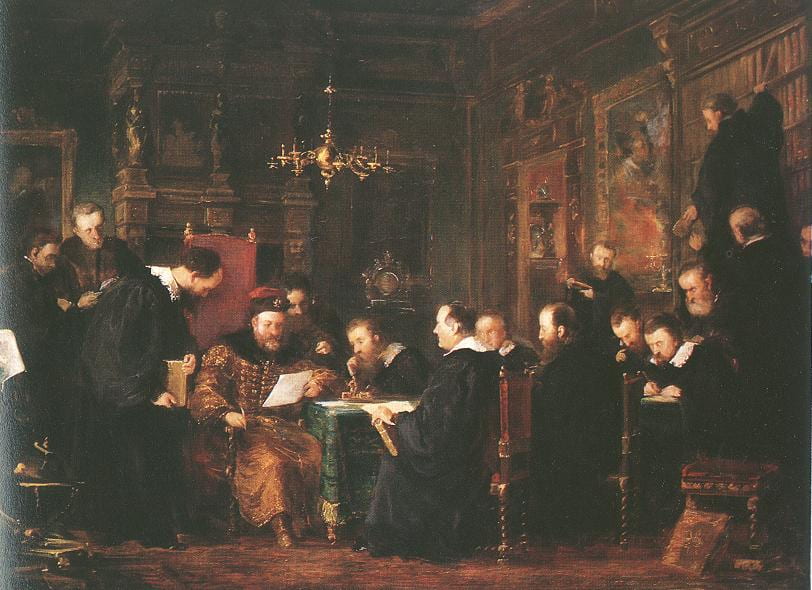
David W. Blight, American Oracle: The Civil War in the Civil Rights Era (The Belknap Press of Harvard University Press, 2011).
Derek
David W. Blight, American Oracle: The Civil War in the Civil Rights Era (The Belknap Press of Harvard University Press, 2011).
I don’t think that the Civil War (1861-1865) has ever been quiescent in American culture and popular consciousness. In the 150 years since, though, major bouts of mythmaking and other engagement with the war’s legacy have stirred in roughly fifty-year increments: the widespread memorialization of the Confederacy and contemporaneous emergence of the Dunning School in the early 20th century; the War’s centennial celebrations in the early 1960s and the Civil Rights movement’s indictment of Emancipation’s miscarried promise; our ongoing debates over the meaning of Confederate flags and memorials and–more important–the historical trajectory linking enslavement, Jim Crow law, and race-based inequality today. Each time, our relationship to the war refracts through these layers of interpretation.
Over the past ten days, I led a high school student tour about the history of the U.S. South and, in particular, the many memorial projects that seek to tell the story of the Civil War and Civil Rights movement. The monuments, historical landmarks, and history museums clustered in cities and scattered in towns across Georgia, Alabama and Mississippi (where we traveled) tell many and often conflicting histories. The new, arresting Legacy Museum and National Memorial for Peace and Justice in Montgomery (realized by the Equal Justice Initiative) have become perhaps the major tourist attractions in the state, suggesting where the momentum is in the popular telling of southern history.
As our group encountered this broader memorial cacophony, David Blight’s absorbing portraits of four men who wrote about the Civil War during its sesquicentennial was a compelling guide. Organized around the troubling federally-sponsored centennial celebration of the Civil War, Blight’s book delves deeply into their attempts to challenge and reframe popular understanding of that conflict and its legacy in the 1950s and 1960s: Robert Penn Warren’s scholarly and fictional writing about the war, Bruce Catton’s wildly popular narrative histories, Edmund Wilson’s literary criticism, and James Baldwin’s much better known oeuvre. Each quarter fascinates and inspires one to read these authors, whom Blight relates around their shared engagement with the tragic dimensions of American history. “The grain against which they wrote was the powerful post-World War II and Cold War American confidence that their past and present could always somehow be woven into a pleasing tale of consensus and the righteous progress of a problem-solving, redemptive people”(27). Blight’s book is a portal that helps us see the stakes of that question in the turbulent 1960s. But it also artfully explores how these authors engaged with the myths of American history, in ways that can inform our own readings of the nation today.
Pranav
The Collected Poems of A.E. Housman (New York: Henry Holt and Co., 1959).
March is always a strange month. It is still cold outside but one takes solace in the longer and occasionally sunny days. The imminent joys of spring and summer excite the imagination but a tinge of nostalgia for snowy winter evenings continues to lurk around.
In such circumstances, I find it difficult to pick up something suitable to read. However, this year, the choice was made easier by a recent chat with a friend which reminded me of a brief pilgrimage of sorts that I made last summer. Ever since I first watched it a few years ago, I’ve always been a big admirer of the 1980s-90s British TV show Inspector Morse, which deftly began with televising some of Colin Dexter’s novels but gradually went on to acquire a life of its own. The titular character, known only by his last name Morse, is an enigmatic figure who, despite a lifetime of disappointments, continues to find meaning in life through his work and his two loves, beer and opera. Despite his eccentricities, he is a character that one can easily sympathize with. Naturally, as I watched episode after episode a few years ago, I myself developed a measure of sympathy for Morse. Therefore, in the last episode (spoiler ahead), when Morse died of a stroke in the quad of Exeter College, Oxford, I was taken aback.

Front Quad, Exeter College, Oxford
It was not the ending I had hoped for and I was left with some serious dislike for the last episode. However, at some point last year, I decided to give it another go and re-watched the last episode with less aversion. Needless to say, once I had decided to be more open-minded, I appreciated it a lot more and one scene, in particular, was lodged in my memory. As was his habit, Morse at one point gets tired and decides to drag his subordinate officer Lewis to a pub. In an eerie foreshadowing of his death in the show, Morse then recites A.E. Housman’s poem “The Remorseful Day” (also the title of the episode) overlooking a beautiful sunset. This brief two minute segment is, I think, one of the most meaningful and poignant scenes that I have ever watched. Its poignancy was only enhanced when I later learned that the actor John Thaw who played Morse in the show himself died of a stroke a few years after the last episode was shot.
Last summer, while doing research at the Bodleian in Oxford, I and some friends decided to punt down to Victoria’s Arms, the pub where the scene was filmed and pay our homage to Morse and Thaw. I was glad to see that a body named The Inspector Morse Society had decided to put a plaque inside the pub which read “This plaque commemorates filming that took place here for the Inspector Morse television series. Near this sport Inspector Morse recited ‘The Remorseful Day’ to Sergeant Lewis in the episode of that name.” It further noted that the plaque had been unveiled by Colin Dexter who created the character Morse and whose novels, as mentioned above, provided the screenplay for many episodes. For a Morse fan like me, it was a very heartening thing to see.
In any case, after I returned from England and settled back into my academic routine, I had forgotten all about Morse and Housman until the aforementioned chat with a friend reminded me of the poem. In the strangeness of March, it struck me that Housman with his crisp descriptions of natural beauty, and profound and elegiac reflections on the passage of time would make for the ideal distraction from the enjoyable but occasionally tedious preparation for my forthcoming oral exams. I got hold of a copy of Housman’s collected poems and was not disappointed.
In his lifetime, Housman was primarily known for his classical scholarship (despite having flunked out of Oxford, he somehow managed to continue independent research and was later appointed Professor of Latin at Cambridge). However, he also continued to write poetry on the side. Though he only published two major collections, his fame as a poet grew considerably in his lifetime and, particularly during and after the First World War, he became one of the most widely read poets in Britain. Housman wrote primarily on two themes: the beauty of the English countryside and the tragic deaths of millions of soldiers in the many wars that Britain participated in over the course of Housman’s lifetime. Though not exactly compatible, the two themes fit together well in Housman’s poetry which achingly speaks of idyllic landscapes left hauntingly desolate by those who never returned to them. Most of the poems make for difficult reading and, at times, it can be agonizing to be constantly reminded of the horrors of modern warfare. Yet, if Archbishop Laud spoke of the “beauty of holiness” (I am obliged to indulge the 17th century historian inside me in everything I write), Housman was perhaps the quintessential prophet of the “beauty of sadness.” In this month of changing seasons, I’ve found him to be the ideal companion.
I leave you with two very different excerpts from Housman’s poems, one from “The Remorseful Day,” and the other from the very dramatic and disturbing “Hell’s Gate.”
“The Remorseful Day”
How clear, how lovely bright,
How beautiful to sight
Those beams of morning play;
How heaven laughs out with glee
Where, like a bird set free,
Up from the eastern sea
Soars the delightful day
“Hell’s Gate”
And the hollowness of hell
Sounded as its master fell,
And the mourning echo rolled
Ruin through his kingdom old.
Tyranny and terror flown
Left a pair of friends alone,
And beneath the nether sky
All that stirred was he and I.
Luna
Leonardo Sciascia, The Council of Egypt (Il Consiglio d’Egitto), trans. Adrienne Foulke (London: Carcanet, 1988).
In my work, I increasingly find myself thinking about ways to determine what counts as evidence, and what theoretical difference exists between documents, data, and other forms of representation. With the work of philosophers such as Bruno Latour and Karen Barad, scholarly discussions in the past three decades have in fact called attention to the socio-cultural processes that make the distinction between these different categories possible. If one accepts that each category indicates different approaches for collecting, structuring, and using information, such a distinction becomes blurred, thus undermining crucial disciplinary boundaries and posing fundamental ethical questions. Not only is the separation between sciences and humanities questioned, but also the very possibility to create reliable accounts of events which were or are occurring in a given context.

Leonardo Sciascia, The Council of Egypt (Il Consiglio d’Egitto), trans. Adrienne Foulke (London: Carcanet, 1988).
With these questions in mind, I started reading Leonardo Sciascia’s Il Consiglio d’Egitto (The Council of Egypt), intrigued by the many definitions that critics coined for his work. Scholars have in fact used different labels, such as “historical fiction,” “detective fiction,” and “historical investigation”, in the attempt to capture the hybrid quality of his writing. Published in 1963, Il consiglio d’Egitto focuses on the late-18th century historical episode of the fraudulent translation of two Arabic codices by the Maltese Abbot, Giuseppe Vella, and on the vicissitudes of his contemporary, the Sicilian jurist, revolutionary, and writer, Francesco Paolo Di Blasi, who was executed by decapitation in Palermo in 1795. The Vella plotline is particularly interesting for anyone concerned with the possible relationship between history and fiction, particularly when considering the cultural processes which define not only such disciplinary distinction but also the parameters for the identification of documents and reliable data.
The novel creates in fact a puzzling mirroring structure in which the Abbot’s forgery of both documents and history casts shade on Sciascia’s attempt to retell the historical past as a writer. For me, and perhaps for historians, the most puzzling aspect of Il Consiglio d’Egitto does not lie in Sciascia’s manipulation of the historical genre, but in his decision to focus on verifiable historical characters and thus on the implications of his own writing in relation to both documented facts and non-historian readers. The novel espouses in fact not only the relevance of understanding what counts as reliable documents and what doesn’t, but also the responsibility of those who make such a decision while reconstructing probable chains of connections in the attempt to define what happened.
According to Sciascia the author, unlike the historian, is not constrained by the limits of what can be verified through documentation, but can instead base his reconstruction also on intuitive and human truths, and therefore literature “è la più assoluta forma che la verità possa assumere” (‘is the most absolute form that truth can assume’) (Ambroise II 834). Il consiglio d’Egitto effectively dramatizes the tension between historical and narrative writing in relation to the truth of the past in order to ask crucial ethical questions about storytelling. Although, many scholars have reacted to the dangers of a “constructivist” approach to history, it is also productive to engage with the questions that authors like Sciascia pose to historians. Sciascia’s work represents an ideal thinking lab for dealing with a text that questions the divide between history and fiction, not from a speculative point of view, but within the writing itself. I definitely need more time to decide whose perspective is more convincing.




Leave a Reply